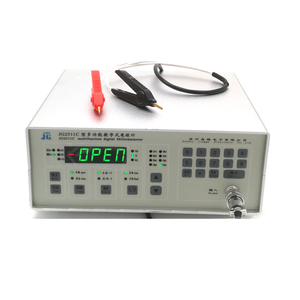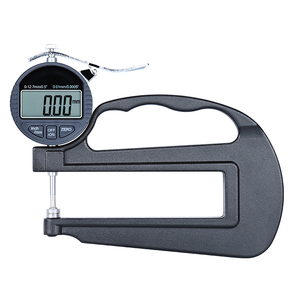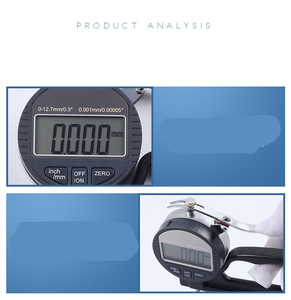
All categories
Featured selections
Trade Assurance
Buyer Central
Help Center
Get the app
Become a supplier

(911 products available)


































Deep-throat micrometers are measuring tools that feature extending jaws designed to measure the width of deep grooves or slots accurately. Instrument and equipment deep-throat micrometers are available in the following types:
The digital deep-throat micrometer has an LCD that makes it easy to read, even when measuring small distances. Moreover, it uses a battery, improving measuring speed with high accuracy, especially while measuring deep grooves. The measuring faces of the digital deep-throat micrometer are normally wider and thicker compared to the mechanical versions. This makes their application in the measurement of small diametric dimensions of thin-walled tubes, among many other precision tasks.
The internal deep-throat micrometer commonly has an inside measuring capability; hence, it is primarily required for measuring the inside diameter of cylindrical workpieces, i.e., pipes. This tool has three to five probe tips, with different widths that fit into the tubular/conic holes. The precise readings are displayed on a micrometer screw gauge, which is turned to find the required measurement that needs to be obtained. Internal deep-throat micrometers are used in machine shops for engine parts.
The adjustable deep-throat micrometer measures width and adds fitting accuracy because its measuring tips can be adjusted. This versatility allows the tool to be used in many applications, as one meter can measure various slots or grooves. The tool is commonly employed in applications where deep-throat micrometer fixed gauges are essential to set at different groove widths or depths to make efficiency comparisons. Because extra measuring tools are used, adjustable deep-throat micrometers are mainly used in factory environments where precise measurements for adjustments are needed for different production processes.
Geneva Internal deep-throat micrometer sets come with more than one micrometer in each set, often comprising three to five different micrometers, which are used to measure various internal diameters. Each micrometer is matched with a probe that is different in size, and this combination enables the tool to measure more than one internal dimensional parameter accurately. Where precision machining on holes or grooves is needed, go for internal deep-throat micrometer sets, for instance, in aerospace and engineering fields, and in these places, one needs to carry out several tests on parts with internal dimension requirements that are extremely accurate.
The deep-throat micrometers are used to measure the width of the groove in the mechanical components. This is especially needed in industries like automotive and aerospace, where the precision of machine parts is required. By accurately checking groove widths, industries can make sure components work well, meet design specs, and avoid early wear or mechanical failures. In the end, deep-throat micrometers are important in maintaining functioning and security in machines' complicated structure.
In manufacturing, deep-throat micrometers measure slot depth in tools like cutting dies and inserts. These measurements affect how tools cut, shape, and manufacture materials. Deep-throat micrometer precision is important in industries like machining and fabrication, where tools must meet design standards. Accurate measurements lead to longer tool life, reduced production time, and better product quality by preventing incorrect or inefficient tools.
Deep-throat micrometers measure the internal diameters of the cylindrical parts used for pipes, tubes, and cylinders in various industries like oil and gas and chemical processing. In structural integrity and system performance, accuracy is very important. Deep-throat micrometers help to ensure components fit properly within other parts or systems. This accuracy causes efficiency and safety. For example, an internal diameter measurement on a pressure pipe ensures that it can withstand system pressures without leaking or breaking.
In quality assurance and control, deep-throat micrometers test the precision of mechanical parts during production and after assembling parts. This ensures that parts work as they should and all parts meet industry standards and requirements. Deep-throat micrometers are particularly useful for testing grooves, slots, and other complex internal/external shapes. By catching dimensional errors early, there is reduced risk of part failure in the field, saving time and cost and preventing potential safety issues caused by malfunctioning parts.
Deep-throat micrometers measure the thickness of materials when they are layered, for instance, in composites or non-destructive testing. The measurement helps determine the thickness of individual layers in materials like paint, insulation, and others. This is also important in industries like aerospace, automotive, construction, and marine, where materials undergo extensive testing to ensure that they meet safety and performance requirements. By providing accurate thickness measurements, deep-throat micrometers help improve material performance and early detection of defects such as delamination.
Measurement range
A deep-throat micrometer can have different measurement ranges, depending on how significant the internal slot or groove people want to measure is. This tool usually ranges from 0 to 1 inch or millimeter maturity to several inches or millimeters.
Accuracy and resolution
Micrometers are measurement tools that come with accuracy and resolution. Most digital deep-throat micrometers hold accuracy within ±0.001 inch or ±0.01 millimeter resolution, which can be small measurements of about 0.0001 inch or 0.1 millimeter. There may be small variations in the accuracy and resolution of a specific tool, depending on its type and range.
Material construction
Deep-throat micrometers are generally made with high-grade steel or stainless steel to ensure that they are very precise and effective and that the tools will not rust or wear down from everyday use. Only the measuring surfaces are made of hardened steel for long-term accuracy.
Turning the screw
The micrometer screw is marked with the thimble, and the user turns it to make contact with the object being measured and to get the measurement. In a digital micrometer, the screw can simply be turned to ensure that the value shown is the one recorded. In a vernier micrometer, the screw must always be locked to secure the measurement.
Jaws design
The unique feature of a deep-throat micrometer is the jaws design, with a front jaw that extends deeply into slots or grooves for measurement while leaving a rear that is short. This design is ideal for measuring groove width and depth.
Unpacking
Remove all the items from the deep-throat micrometer package and ensure that none are damaged. Deep-throat micrometers' jigs and fixtures should be permanent.
Calibration
Calibration is critical for deep-throat micrometers used in close-tolerance applications. Before using the tools, one should check the calibration of the tools or have them professionally calibrated.
Mounting the micrometer head
Ensure that the micrometer head is accessible very easily and that the measuring faces are also in contact with the cylindrical surface.
Securing the micrometer head
Once the micrometer head is in the right position, fix it with set screws so that it will not move while taking the measurement. For micrometers with multiple heads, ensure that the head used is the correct one for the measurement.
Adjusting the depth of the micrometer
The depth of the micrometer should be adjusted so that the measuring jaws extend far enough into the groove or slot for measurement but not so far as to hit the opposite side.
Locking the adjustment
Once the depth is set, lock it to prevent movement during measurement. Most micrometers have a locking feature that secures the adjustment.
Select the appropriate micrometer
Choose the deep-throat micrometer that fits the slot or groove width and depth to be measured. If multiple micrometers are available in sets, select the one that has measurement ranges close to the target measurement.
Clean the tool
Ensure the micrometer is clean before use. Use a soft cloth to wipe the measuring jaws and thimble to remove any dust or debris that may interfere with the measurement.
Zero the micrometer
If using a digital micrometer, press the 'zero' button to set the display to zero. For analog micrometers, close the jaws and note the reading on the thimble, then rotate the thimble until the main scale aligns with the thimble scale.
Position the micrometer
Slide the deep-throat jaws into the groove or slot being measured. Ensure the jaws are parallel to each other and that the measuring faces touch the groove's sides.
Take the measurement
Slowly rotate the thimble until it touches the object. Take the measurement and record it. If using a digital micrometer, the measurement will be displayed on the screen.
Repeat if necessary
For more accurate results, take multiple measurements at different points within the groove or slot, then calculate the average.
Clean daily
It is important to clean the surface of any device, tool, or appliance after each use. After every use, read the instructions on how to clean the digital micrometer for best results. One should also apply a thin layer of oil on parts susceptible to rust.
Calibrate regularly
A calibration schedule should be set based on the operation environment and usage frequency. In rough or heavy applications, calibrate monthly, or weekly and seasonally in low usage environments. Always calibrate after repairs, replacing worn parts, or when the tool has been stored for a long time.
Proper storage
Keeping a digital caliper micrometer at work during hot and humid days ensures it will gauge accurately. Indoor storage in cool, dry, non-hazardous conditions keeps it measuring true. While at work, treat it gently to maintain its sensitivity and measurement capacity. Find a safe location for it where it will not be easily damaged or break.
Wear check
Check for signs of wear or damage to gaskets, seals, and other parts that might be damaged by wear. If there is any wear seen on the measuring jaws and other assessment parts, then they have to be replaced or repaired immediately.
Measurement range
Choose a slot or groove width and depth that fits a micrometer. Each deep-throat micrometer has its measurement range. Therefore, ensure that the micrometer can make the required measurements.
Resolution and accuracy
Opt for high-resolution micrometers when precise measurements are highly needed in the projects. These help resolve small measurement changes and improve accuracy, giving more dependable results each time the measurements are taken. An internal micrometer has a small error or an amount of imprecision compared to an external micrometer, which, when used in thickness measurement, improves accuracy in measurements to a greater extent.
Digital vs. mechanical
Digital micrometers display zero can be done easily. Most of them also come with a metric and imperial switch measurement and an easy measurement recall switch. On the other hand, mechanical micrometers give the feel of traditional measurement tools.
Material construction
Choose one made of stainless steel, ensuring longevity and wear resistance. Internal and external micrometers get affected by the environmental condition they are placed in. If used in humid environments, it may be advisable to have a model made of stainless steel.
Ergonomic design
Because measurements usually take time, look for micrometers with an ergonomic grip for longer measurements. It is, therefore, necessary to consider a micrometer with a firm and comfortable grip, especially when taking measurements for a longer period.
Deep-throat micrometers are selected based on such factors as the project's working demands and the user's personal preferences. When making a choice, the measurement range of the micrometer should be with slot or groove depth and width. Select a digital micrometer if a simple and more accurate measurement is required. However, they are basically mechanical users who prefer traditional measuring instruments. Make sure it is made of stainless steel for longevity. One should hold the micrometer in hand to decide if it is comfortable. Buy it from a reputable company, then get spare parts for it. Finally, seek professional calibration for accuracy.
Internal and external
Internal micrometers measure inside slots and grooves, while external ones measure outside. Internal micrometers use special probes that fit inside for precise readings, while external ones measure widths across surfaces using jaws that grip them. Both are necessary for design and engineering but different needs. Internal micrometers are more complex, while external ones are simpler to use.
Digital and mechanical
Digital micrometers provide a clear, simple number on the screen with internal and external measurements. They also recall past measurements and switch between metric and imperial systems easily. Mechanical micrometers are traditional, requiring more focus on the tiny lines for internal and external measurements. They are simple, without batteries.
Accounting1) deep-throat micrometers are typically used in the mechanical engineering industry, automotive industry, aerospace, manufacturing, and machining industry.) They are used in quality control and testing in other industries, such as the medical and petroleum industries.
The primary function of a deep-throat micrometer is to measure the width and depth of slots and grooves in mechanical parts.
An internal deep-throat micrometer measures the width of grooves and slots from the inside, while an external one measures the thickness of materials by applying the jaws outside.
Digital deep-throat micrometers have an electronic display that makes the reading easy, and they often include additional features, such as measurement switching and data storage. This makes them more accurate and effective than mechanical ones: measurements.
Deep-throat micrometer maintenance involves regular cleaning after use, calibration, and inspection for wear or damage. It should also be stored properly in a dry, clean environment to ensure accuracy and extend its lifespan.